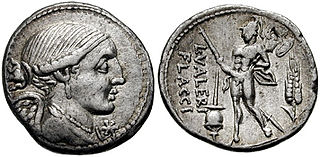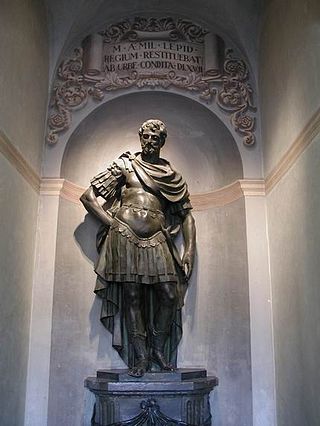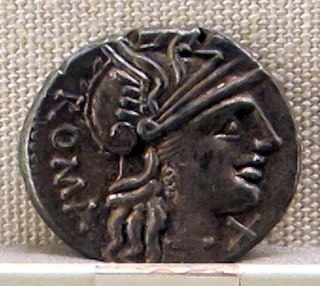Related Research Articles
Quintus Fulvius Flaccus, son of Marcus Fulvius Flaccus, was consul in 237 BC, fighting the Gauls in northern Italy. He was censor in 231 BC, and again consul in 224 BC, when he subdued the Boii. He was a praetor in 215 BC and in 213 BC Master of Horse in the dictatorship of Gaius Claudius Centho.

The gens Valeria was a patrician family at ancient Rome, prominent from the very beginning of the Republic to the latest period of the Empire. Publius Valerius Poplicola was one of the consuls in 509 BC, the year that saw the overthrow of the Tarquins, and the members of his family were among the most celebrated statesmen and generals at the beginning of the Republic. Over the next ten centuries, few gentes produced as many distinguished men, and at every period the name of Valerius was constantly to be found in the lists of annual magistrates, and held in the highest honour. Several of the emperors claimed descent from the Valerii, whose name they bore as part of their official nomenclature.
The gens Sulpicia was one of the most ancient patrician families at ancient Rome, and produced a succession of distinguished men, from the foundation of the Republic to the imperial period. The first member of the gens who obtained the consulship was Servius Sulpicius Camerinus Cornutus, in 500 BC, only nine years after the expulsion of the Tarquins, and the last of the name who appears on the consular list was Sextus Sulpicius Tertullus in AD 158. Although originally patrician, the family also possessed plebeian members, some of whom may have been descended from freedmen of the gens.

Manius Curius Dentatus was a Roman general and statesman noted for ending the Samnite War and for his military exploits during the Pyrrhic War. According to Pliny, he was born with teeth, thus earning the surname Dentatus, "toothed."

The gens Fabia was one of the most ancient patrician families at ancient Rome. The gens played a prominent part in history soon after the establishment of the Republic, and three brothers were invested with seven successive consulships, from 485 to 479 BC, thereby cementing the high repute of the family. Overall, the Fabii received 45 consulships during the Republic. The house derived its greatest lustre from the patriotic courage and tragic fate of the 306 Fabii in the Battle of the Cremera, 477 BC. But the Fabii were not distinguished as warriors alone; several members of the gens were also important in the history of Roman literature and the arts.
The gens Fulvia, originally Foulvia, was one of the most illustrious plebeian families at ancient Rome. Members of this gens first came to prominence during the middle Republic; the first to attain the consulship was Lucius Fulvius Curvus in 322 BC. From that time, the Fulvii were active in the politics of the Roman state, and gained a reputation for excellent military leaders.

Marcus Aemilius Lepidus was a Roman consul, Pontifex Maximus, Censor and Princeps Senatus. A scion of the ancient Patrician gens Aemilia, he was most likely the son of Marcus Aemilius Lepidus, with his brothers being Lucius and Quintus.
Marcus Fulvius Nobilior was a Roman general.
Quintus Fabius Q. f. M. n. Maximus Gurges, the son of Quintus Fabius Maximus Rullianus, was consul in 292, 276, and 265 BC. After a dissolute youth and a significant military defeat during his first consulate, he was given the opportunity to salvage his reputation through the influence of his father, and became a successful general, eventually holding the highest honours of the Roman state. He was slain in battle during his third and final consulate.
Marcus Fulvius Flaccus was a Roman senator and an ally of the Gracchi. He served as consul in 125 BC and as plebeian tribune in 122 BC.
Publius Licinius Crassus Dives was consul in 205 BC with Scipio Africanus; he was also Pontifex Maximus since 213 or 212 BC, and held several other important positions. Licinius Crassus is mentioned several times in Livy's Histories. He is first mentioned in connection with his surprising election as Pontifex Maximus, and then several times since in various other capacities.
Publius Sempronius C.f. Tuditanus was a Roman Republican consul and censor, best known for leading about 600 men to safety at Cannae in August, 216 BC and for the Treaty of Phoenice which ended the First Macedonian War, in 205 BC.

Quintus Caecilius Metellus was a pontiff in 216 BC, aedile of the plebeians in 209 BC, curule aedile in 208 BC, magister equitum in 207 BC, consul in 206 BC, dictator in 205 BC, proconsul of Bruttium in 204 BC, and an ambassador at the court of Philip V of Macedon in 185 BC.

The gens Minucia was an ancient Roman family, which flourished from the earliest days of the Republic until imperial times. The gens was apparently of patrician origin, but was better known by its plebeian branches. The first of the Minucii to hold the consulship was Marcus Minucius Augurinus, elected consul in 497 BC.
Lucius Valerius Flaccus was a Roman politician and general. He was consul in 195 BC and censor in 183 BC, serving both times with his friend Cato the Elder, whom he brought to the notice of the Roman political elite.

Roman Republican governors of Gaul were assigned to the province of Cisalpine Gaul or to Transalpine Gaul, the Mediterranean region of present-day France also called the Narbonensis, though the latter term is sometimes reserved for a more strictly defined area administered from Narbonne. Latin Gallia can also refer in this period to greater Gaul independent of Roman control, covering the remainder of France, Belgium, and parts of the Netherlands and Switzerland, often distinguished as Gallia Comata and including regions also known as Celtica, Aquitania, Belgica, and Armorica (Brittany). To the Romans, Gallia was a vast and vague geographical entity distinguished by predominately Celtic inhabitants, with "Celticity" a matter of culture as much as speaking gallice.

Quintus Fabius Maximus was a consul of the Roman Republic in 213 BC. He was the son of Quintus Fabius Maximus Verrucosus, the famous dictator who invented Fabian strategy, and served with his father during the Second Punic War.
Gnaeus Fulvius Centumalus Maximus was a consul of the Roman Republic in 211 BC. As consul, Fulvius defended Rome against Hannibal with his colleague Publius Sulpicius Galba Maximus during the Second Punic War.
The gens Laetoria was a plebeian family at ancient Rome. Its members appear regularly throughout the history of the Republic. None of the Laetorii ever obtained the consulship, but several achieved lesser offices of the Roman state.
References
- ↑ Oxford Classical Dictionary, "Fulvius Flaccus (2), Quintus"
- ↑ E. Badian, "The Consuls, 179-49 BC", Chiron, 20 (1990), p. 374
- ↑ Livy 39.39.1–15, but Livy says Fulvius Flaccus was only aedile designate; see Broughton, MRR1, p. 377, note 1, for a summary of the constitutional intricacies, based on Theodor Mommsen's arguments.
- ↑ Livy 40.16.7–10.
- ↑ Livy 40.18.6, 40.30.1–33.9, 40.35.3–36.13, 40.40.15, 42.34.9, 43.4–7; Diodorus Siculus 29.28; Frontinus, Stratagems 2.5.8 (where Cimbrico is taken as an error for Celtiberico; Appian, Iberian Wars 42; Orosius 4.20.31.
- ↑ Livy 40.44.3.
- ↑ Livy 40.53.1–6; Florus 1.19.5.
- ↑ Livy 40.59.1–3.
- ↑ Livy 40.44.8–12 and 45.6.
- ↑ Livy 41.27.2; Valerius Maximus 2.7.5; Velleius Paterculus 1.10.6; Frontinus, Stratagems 4.1.32.
- ↑ Livy 41.27.1.
- ↑ Livy 41.27.1–2 and 5–13.
- ↑ Valerius Maximus (1.1.20) places this temple in Locri, Bruttium, but elsewhere correctly identifies its location as Croton, also in modern-day Calabria; see also Livy 42.3.1–11.
- ↑ Livy 42.10.5.
- ↑ Livy 42.28.10–12. Discussed at length by Hans-Friedrich Mueller, Roman religion in Valerius Maximus (Routledge, 2002), p. 35ff. online.
- ↑ Livy provides a practical detail: that the tiles were then left stacked within the temple precinct because there was no workman to restore them.